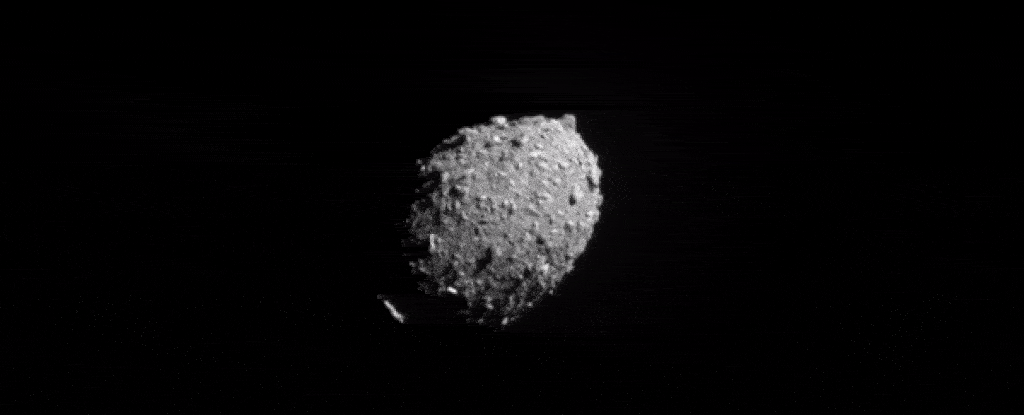On Sept. 26th, 2022, NASA’s Double Asteroids Redirect Test (DART) collided with Dimorphos, the small moonlet orbiting the larger asteroid Didymos.
In so doing, the mission successfully demonstrated a proposed strategy for deflecting potentially hazardous asteroids (PHAs) – the kinetic impact method.
By October 2026, the ESA’s Hera mission will rendezvous with the double-asteroid system and perform a detailed post-impact survey of Dimorphos to ensure that this method of planetary defense can be repeated in the future.
However, while the kinetic method could successfully deflect asteroids so they don’t threaten Earth, it could also create debris that might reach Earth and other celestial bodies.
In a recent study, an international team of scientists explored how this impact test also presents an opportunity to observe how this debris could someday reach Earth and Mars as meteors.
After conducting a series of dynamic simulations, they concluded that the asteroid ejecta could reach Mars and the Earth-Moon system within a decade.
The research team was led by Dr. Eloy Peña-Asensio, a Research Fellow with the Deep-space Astrodynamics Research and Technology (DART) group at the Polytechnic Institute of Milan.
He was joined by colleagues from the Autonomous University of Barcelona, the Institute of Space Sciences (ICE-CSIS), part of the Spanish National Research Council, the Catalonia Institute of Space Studies (IEEC), and the European Space Agency (ESA).
The paper that details their findings recently appeared online and has been accepted for publication by The Planetary Science Journal.
For their study, Peña-Asensio and his colleagues relied on data obtained by the Light Italian CubeSat for Imaging of Asteroids (LICIACube), which accompanied the DART mission and witnessed the kinetic impact test.
This data allowed the team to constrain the initial conditions of the ejecta, including its trajectories and velocities – ranging from a few tens of meters per second to about 500 m/s (1800 km/h; ~1120 mph). The team then used the supercomputers at NASA’s Navigation and Ancillary Information Facility (NAIF) to simulate what will become of the ejecta.
These simulations tracked the 3 million particles created by the DART mission’s impact with Dimorphos. As Peña-Asensio told Universe Today via email:
“LICIACube provided crucial data on the shape and direction of the ejecta cone immediately following the collision.
In our simulation, the particles ranged in size from 10 centimeters to 30 micrometers, with the lower range representing the smallest sizes capable of producing observable meteors on Earth with current technology. The upper range was limited by the fact that only ejected centimeter-sized fragments were observed.”
Their results indicated that some of these particles would reach Earth and Mars within a decade or more, depending on how fast they traveled after the impact.
For example, particles ejected at velocities below 500 m/s could reach Mars in about 13 years, whereas those ejected at velocities exceeding 1.5 km/s (5,400 km/h; 3,355 mph) could reach Earth in as little as seven years. However, their simulations indicated that it will likely be up to 30 years before any of this ejecta is observed on Earth.
“However, these faster particles are expected to be too small to produce visible meteors, based on early observations,” said Peña-Asensio.
“Nevertheless, ongoing meteor observation campaigns will be critical in determining whether DART has created a new (and human-created) meteor shower: the Dimorphids. Meteor observing campaigns in the coming decades will have the last word.
“If these ejected Dimorphos fragments reach Earth, they will not pose any risk. Their small size and high speed will cause them to disintegrate in the atmosphere, creating a beautiful luminous streak in the sky.”
Peña-Asensio and his colleagues also note that future Mars observation missions will have the opportunity to witness Martian meteors as fragments of Didymos burn up in its atmosphere.
In the meantime, their study has provided the potential characteristics these and any future meteors burning up in our atmosphere will have. This includes direction, velocity, and the time of the year they will arrive, allowing any “Dimorphids” to be clearly identified. This is part of what makes the DART mission and its companion missions unique.
In addition to validating a key strategy for planetary defense, DART has also provided an opportunity to model how ejecta caused by impacts could someday reach Earth and other bodies in the Solar System. As Michael Küppers, the Project Scientist of the ESA’s Hera mission and co-author of the paper, told Universe Today via email:
“A unique aspect of the DART mission is that it is a controlled impact experiment, i.e., an impact where the impactor properties (size, shape, mass, velocity) are accurately known.
Thanks to the Hera mission, we will also know the target properties well, including those of the DART impact site. Data about the ejecta came from LICIACube and earth-based observations after the impact.
There is probably no other impact on a planetary scale with that much information about the impactor, the target, and the ejecta formation and early development. This allows us to test and improve our models and scaling laws of the impact process and ejecta evolution. Those data provide the input data (source location, size, and velocity distribution) used by the ejecta evolution models.”
This article was originally published by Universe Today. Read the original article.





